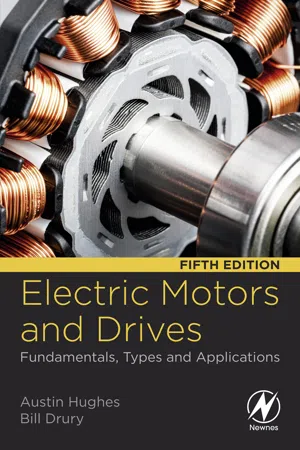
- 511 pages
- English
- ePUB (mobile friendly)
- Available on iOS & Android
About this book
Electric Motors and Drives: Fundamentals, Types and Applications, Fifth Edition is intended primarily for non-specialist users or students of electric motors and drives, but many researchers and specialist industrialists have also acknowledged its value in providing a clear understanding of the fundamentals. It bridges the gap between specialist textbooks (too analytical for the average user) and handbooks (full of detail but with little insight) providing an understanding of how each motor and drive system works.The fifth edition has been completely revised, updated and expanded. All of the most important types of motor and drive are covered, including d.c., induction, synchronous (including synchronous reluctance and salient Permanent Magnet), switched reluctance, and stepping. There has been significant innovation in this area since the fourth edition, particularly in the automotive, aircraft and industrial sectors, with novel motor topologies emerging, including hybrid designs that combine permanent magnet and reluctance effects. We now include a physical basis for understanding and quantifying torque production in these machines, and this leads to simple pictures that illuminate the control conditions required to optimise torque. The key converter topologies have been brought together, and the treatment of inverter switching strategies expanded.A new chapter is devoted to the treatment of Field Oriented control, reflecting its increasing importance for all a.c. motor drives. A unique physically-based approach is adopted which builds naturally on the understanding of motor behaviour developed earlier in the book: the largely non-mathematical treatment dispels much of the mystique surrounding what is often regarded as a difficult topic.- Helps users acquire knowledge and understanding of the capabilities and limitations of motors and drives without struggling through unnecessary math and theory- Presents updated material on the latest and most widely-used motors and drives, including brushless servo motors- Includes additional diagrams and worked examples throughout this updated edition- Includes a physical basis for the understanding and quantifying torque production
Frequently asked questions
- Essential is ideal for learners and professionals who enjoy exploring a wide range of subjects. Access the Essential Library with 800,000+ trusted titles and best-sellers across business, personal growth, and the humanities. Includes unlimited reading time and Standard Read Aloud voice.
- Complete: Perfect for advanced learners and researchers needing full, unrestricted access. Unlock 1.4M+ books across hundreds of subjects, including academic and specialized titles. The Complete Plan also includes advanced features like Premium Read Aloud and Research Assistant.
Please note we cannot support devices running on iOS 13 and Android 7 or earlier. Learn more about using the app.
Information
Electric motors—The basics
Abstract
Keywords
1.1 Introduction
1.2 Producing rotation

1.2.1 Magnetic field and magnetic flux

Table of contents
- Cover image
- Title page
- Table of Contents
- Copyright
- Preface
- Chapter 1: Electric motors—The basics
- Chapter 2: Power electronic converters for motor drives
- Chapter 3: D.C. motors
- Chapter 4: D.C. motor drives
- Chapter 5: Induction motors—Rotating field, slip and torque
- Chapter 6: Induction motor—Operation from 50/60 Hz supply
- Chapter 7: Variable frequency operation of induction motors
- Chapter 8: Field oriented control of induction motors
- Chapter 9: Synchronous, permanent magnet and reluctance motors and drives
- Chapter 10: Stepping and switched reluctance motors
- Chapter 11: Motor/drive selection
- Appendix: Solutions to review questions
- Further reading
- Index